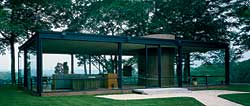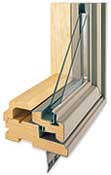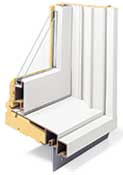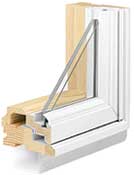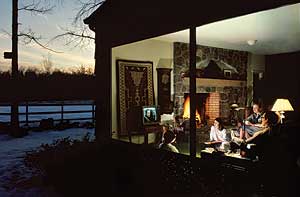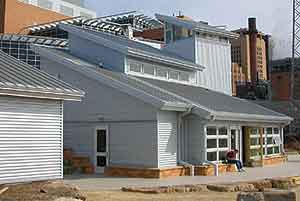Architects' Widening View of Windows: Technical Advances Elevate the Role of Fenestration
![]() Continuing Education
Continuing Education
Use the following learning objectives to focus your study while reading this month’s Continuing Education article.
Learning Objectives - After reading this article, you will be able to:
- Trace the evolution of windows and design and how our culture is shaped and reflected by the use and design of windows
- Understand the importance of taking a holistic approach to fenestration design to consider the historical, social, and cultural context
- Understand how technological advancements redefine what is possible in design and integration of the window components
"The history of architecture is the history of the struggle for the window," Le Corbusier, the master of modernism, said in 1929. If Le Corbusier were alive today, he would find that struggle rages on, with the design and performance of the contemporary window reaching far beyond his imagination. Now instead of considering a window as an opening in a wall for light or ventilation or view, an architect is driven to consider the use of glazing as a defining factor in building design and performance. It's a much more daunting and complicated task - but ultimately a more challenging and rewarding one.
A recent exhibition entitled "Picture This" at the National Building Museum in Washington, D.C., put it this way: "Windows now go well beyond being simple devices that let in light and air. Today they function as integral components of complex building envelopes, selectively filtering aspects of the larger environment. As manufacturers have developed new technologies to improve visibility, security, and comfort, windows have become elements of sophisticated systems that control light, ventilation, moisture, dust, sound, and even infrared and ultraviolet light."
|
|
Most architects are familiar with the state-of-the-art contemporary window. What needs to be pondered is that no other building component has had such a significant impact on design - exterior form, perception of space, relation to exterior space, building performance, exterior and interior detail. The most obvious may be appearance. "The shape, character, and construction of the window have an enormous effect not only on how our buildings work and how it is to live in them, but also how they look," said Howard Decker, curator at the National Building Museum. "Technological development has been a very significant factor in the 20th century dialogue between the window and architecture and now we can make a window look like anything. The question is: what should a window look like?"
Manufacturers today offer architects more options for window design than ever before to address what a window may look like as well as what it can do - infinite degrees of transparency, dozens of framing and opening choices, insulating alternatives, and security features. Thermally, windows compete with insulated walls in terms of the ability to reduce heating and cooling loads. So, in essence, the window has been dissolved into the wall and visa versa.
This new high-performance contribution of the window isn't a given, however, but must be integrated with the total building performance.
Climate, site, building orientation, glazing area, and location are considered extremely important. In other words, only a holistic approach to building design promotes energy efficiency. The fenestration design must also consider HVAC system type and efficiency, utility type and rates, internal loads, window area and orientation, and shading. Determining realistic building performance values requires use of valid performance values of window assemblies for modeling studies. The emphasis on performance-based design, as well as appropriate material and manufacturing processes, may ultimately promote the realities of sustainable architecture.
|
||||||
But back to window technology. To understand where we are, it's important to see where we've come from and how rapidly technology has progressed, particularly in the 20th century. It's also intriguing to try to sort out the chicken-and-egg question about social needs and technology - do our needs push technological development or does technology often precede our mass cultural yearnings? The glass and window industry offers some fascinating insights into social and cultural as well as architectural history.
Manufacturing Glass, First
Since the earth was formed, glass has been made naturally - by high-temperature conditions cooling and solidifying rapidly, like volcanic eruptions, lightning strikes, or the impact of meteorites. Stone-age man used cutting tools of natural glass called obsidian. Glass was first "discovered" by Phoenician merchants around 5000 B.C. While transporting stones of nitrate, the merchants rested cooking pots upon the stones, which eventually mixed with sand on the beach and formed an opaque liquid. The earliest man-made nontransparent glass fragments date back to the 16 century BC and were found in Mesopotamia. A major breakthrough in glassmaking was the discovery of glassblowing some time between 27 BC and AD 14, attributed to Syrian craftsmen.
The Ancient Romans were the first to use glass for architectural purposes, with the discovery of clear glass (through the introduction of manganese oxide) in Alexandria about AD 100. Although of poor quality, cast glass windows appeared in the most important buildings in Rome and the luxury villas of Herculaneum and Pompeii. With the decline of the Roman Empire, progress in the field of glassmaking techniques slowed, however, without any major improvements made until the Middle Ages.
In the 11th century, Germany produced the first glass sheets by a technique that was further developed in the 13th century by Venetian craftsmen.
By blowing a hollow glass sphere and swinging it vertically, gravity would pull the glass into a cylindrical "pod." While still hot, the ends of the pod were cut off and the resulting cylinder cut lengthways and laid flat. Panes of sheet glass, known as crown glass, would be joined with lead strips and pieced together to create windows. At that time glazing was a great luxury, mostly reserved for palaces and churches. Most buildings had small windows and dark and dank interiors. It was more typical for the openings to be shuttered and covered with oil and paper. Large-scale production of sheet glass - enough to bring the development of the manufactured windows industry - didn't occur until the mid 1700s, and even then only the wealthy could afford them.
Innovative Glassmaking Techniques
The Industrial Revolution came and in the span of just two centuries window technology traveled through light years, so to speak, with major implications for architecture. The production of flat glass by breaking and spinning a blown globe gave way to the glass cylinder, blown by using compressed air, which could be slit lengthwise, reheated, and allowed to flatten on an iron table under its own weight. Although the natural fire finish was destroyed on one surface the final product, still far from being truly flat, was flatter than crown glass. Output increased dramatically. By mid 1800s the world was astonished by the design of the Crystal Palace in London, made with 300,000 sheets of cylinder-blown glass set on a lightweight iron framework, a building that is often considered a precursor of the modern movement.
Fundamental to the great increase in glass output was the introduction of the regenerative furnace. Higher temperatures sped up melting times.
The conversion of the old siege floor into a vast tank into which the materials directly flowed allowed the continuous production of molten glass. Windows and window frames were still crafted by hand, but with increased glass production, they became available to a much broader segment of the population.
The late 1800s marked a time of rapid change in domestic architectural styles - some regionally based, some revivalist styles borrowed from Europe, and others more esoteric American inventions. It's fair to say, however, that the window was not a major determining influence in the design of a house. Whether articulated in the language of Beaux Arts, Queen Ann, Tudor, or Craftsman, punched openings in the masonry or timber-framed facades provided minimal visual exposure or ventilation from exterior to the inside and were primarily part of the artistic language. In certain areas, there was a tendency to employ regionally appropriate designs, tall windows that encourages natural ventilation in the south (the French Colonial) and thick walls of adobe, flat roofs, and minor window fenestration in the southwest (the Spanish Colonial) to protect from the intense sun.
Window fenestration on commercial buildings followed that of residential structures, with relatively small punched holes conforming to the overall stylistic architectural expression. Windows were operable, providing natural ventilation and often set deep in the façade and separated by thick piers, a style which characterizes Richardsonian buildings of that era. In the mid to late 19th century, commercial buildings with cast-iron facades presaged curtain-wall construction, and also much of the theory of skyscraper design. While still containing separate window units, these facades whet the appetite for a continuous glassy surface.
Curtain-wall construction, however, wasn't possible until after 1905, when a Belgian named Fourcault managed to vertically draw a continuous sheet of glass of a consistent width from the tank. Commercial production of sheet glass using this method commenced in 1914. Colburn refined this process, with the support of Libbey-Owens in 1917. The Pittsburgh Plate Glass Company (now PPG) updated the process's main features and it was used from 1928 until the company changed to the float glass manufacturing process decades later.
In 1909, the world saw the first example of steel mullioned, strip-windows and uninterrupted steel spandrel façade in the Boley Building in Kansas City. Designed by Louis S. Curtiss, its walls were enclosed by continuous bands of glass, accented slightly by glazed doors, above painted steel spandrel strips.
One other remarkably advanced buildings of its time still stands in San Francisco as a monument to the use of boldly scaled glass. The seven-story Hallidie Building (1917-1918), designed by Willis Polk, is all glass with the exception of four fanciful bands of superimposed cast-iron decoration and fire escapes.
The vanguard of the International Style was emboldened by these advances in window technology. Ludwig Mies van der Rohe, Philip Johnson, Richard Neutra, and others gained prominence in their commercial work by using great expanses of glass to announce that a building's structure no longer needed to be displayed in the building's exterior facade. Then they seized the opportunity to test their modernist theories at the residential scale, creating three-dimensional tributes to the invention of plate glass. In 1938, Richard Neutra designed the "windshield" house for a wealthy family on Fishers Island, New York. Huge sheets of plate glass in metal frames gave the owners sweeping panoramic views.
The Modernist aesthetic of immense slick glass architectural surfaces could filter into the public domain most rapidly with new technology. It was the float process developed after the Second World War by Britain's Pilkington Brothers Ltd. and introduced in 1959 that combined the brilliant finish of sheet glass with the optical qualities of plate glass. Molten glass, when poured across the surface of a bath of molten tin, spreads and flattens before being drawn horizontally in a continuous ribbon into the annealing lehr. The post-war residential building boom brought a newfound consumer interest in the "picture window." Homeowners not only liked the modern style, but also the views and daylight the large windows afforded.
The Hermetically Sealed Building
It's hard to talk in generalities, yet trends can be identified in mid to late 20th century growth: suburbanization, increased density, conformity and standardization of design for middle-class home, glassy and tightly sealed boxes for offices and business. The picture window and the great sheets of plate glass in residential, commercial, and public buildings provided fabulous views and daylight but closed up the buildings to natural ventilation.
|
PICTURE THIS: Windows
on the American Home Picture This: Windows on the American Home explores 200 years of the cultural, aesthetic, and technical accomplishments of windows at the National Building Museum in Washington, D.C. (through August 11th). This exceptionally informative, yet accessible, exhibition was conceived and sponsored by Andersen Corporation in celebration of its 100th anniversary. Picture This explores several themes, each of which elucidates the defining role windows have played in the design and culture of the American home. History meets theory, and invention meets critique, in a robust multimedia presentation - including film and video clips, models, photographs, advertisements, historic artifacts, and a lucid and graphic timeline. The exhibition examines the extent to which technological invention has determined architectural form - before the Industrial Revolution made the dependence transparent - has not often been analyzed outside of academia without being arcane. For more information contact The National Building Museum www.nbm.org or The Minnesota History Centerwww.mnhs.org. |
Advances in heating, air conditioning and ventilation systems followed, ironically leading to the loss of design skill in the use of windows for daylight and ventilation. The technological advances produced a "higher standard of living," but in the process the building occupant's relationship with the natural environment was cut off. The building became a machine for living, but the interior and exterior spaces were isolated one from the other. Again, we're talking cultural attitudes here, in the 1950s and 1960s, when energy sources were plentiful and cheap. Environmental issues revolving around the orientation, size, and shape of windows in a building in relationship to its site and climate sunk deep in many architect's consciousness. The environmental behavior of windows was recognized and studied, but not as an urgent priority.
Then came the energy crises of the 1970s when prices skyrocketed.
The net cost of a window unit was, in effect, increased because its performance in many designs added to the operating expense of the building. Architects and engineers responded and energy-conscious design gained momentum.
Of interest were innovative schemes for day lighting, solar heating and shading in buildings, natural ventilation, and active energy-generating systems such as photovoltaics. Percolation of these design theories into the construction industry, however, proved an ambitious task. When energy prices evened out, smooth skinned glass and steel boxes without operable windows or external sunshades and endless housing tracts developed without regard to site and climate once again became economical and passive solar solutions were nearly abandoned. Only now, with renewed emphasis on sustainable architecture are some of these theories once again seeing the light of day. Yet, the seeds of a different design method were planted. Even the federal government got involved, and in the 1980s promoted the Building Energy Performance Standards, which promoted a performance-based evaluation of a building's design rather than a prescriptive basis.
|
|
At the same time, manufacturers of building components remained concerned with environmental issues, anticipating further world energy resource complications in the future. Window manufacturers offered product solutions. "Thirty years ago, windows were the weakest link in the wall or in the building in terms of thermal energy," says Steve Selkowitz, of Lawrence Berkeley Laboratories, a government agency that has long studied energy use in buildings. "The idea was don't use them or make them as small as possible."
Advances came quickly - single-glazed; double-glazed; triple-glazed; gas-filled insulating glass; quantified heat gain and loss, through conduction as well as infiltration and solar heat gain, using advanced modeling of building performance.
"Now," Selkowitz says, "windows compete with insulated walls in terms of reducing heat and cooling loads."
High performance today is dependent on the entire window assembly, not just the glazing. Since frame and sash materials account for 10 to 30 percent of the total window area, materials have a significant effect on overall performance. Window frames have evolved dramatically from the lead strips that held panes in primitive wood frames. Now they are generally made of wood, vinyl, aluminum, and composites. Materials are now being combined to increase weathering capability, improve structural performance, and reduce maintenance. The material choice has significant performance implications as well as a dramatic impact on the fenestration aesthetic.
A lot of guesswork has been removed from window design and specification in areas of the country vulnerable to extreme forces of nature. Coastal states have been hammered in recent years by more extensive and severe damage from hurricanes and tropical storms, prompting local governments and insurance companies to require protection in the form of shutters, screens, or impact-resistant glazing and frames. After Hurricane Andrew pounded Southern Florida in 1992, the state implemented stringent codes, requiring many new homes within varying proximity to the coast to have impact-resistant window systems. In response, manufacturers have developed a broad portfolio of products with impact-resistant laminated glazing and components to withstand higher design pressures. Social and cultural security concerns also demand sensitive design solutions to physical security requirements. Manufacturers are responding with window systems to withstand varying levels of physical force.
At the same time, window design aesthetics remain a critical part of the package. "The windows are not an eyesore," says Steven Winter, architect and director of Steven Winter Associates. "Not a neces-sary evil. They are something we use for their technical performance as well as their psychological and visual performance…." In fact, Winter refers to decorative windows as "jewelry."
Can the window industry go further? Yes, says Winter, but it's a cost issue. "It used to be that double-glazing was an expensive option. Then it used to be that low-e coatings were luxury options. More and more I see the expensive higher-performance options becoming part of the mainstream. I think that will continue. These days, triple and quadruple glazing is that expensive option. Thermal breaks at the perimeter of glass are an expensive option. They will become the norm."
Selkowitz goes a step further. "Windows are going to be better than the walls that house them. And then that becomes the end of the cycle. The window is no longer the poor cousin, but the rich cousin in the relationship between the fenestration and the opaque part of the wall."
The Search for Sustainability
As architects search for sustainability in design, it demands a clear understanding of the basic principles of energy conservation. Designers must consider the appropriate use of glazing for the specific environmental challenges of each climate, site, and building design program. Appropriate material selection and sensitive manufacturing processes are considered in product selection. The iterative design process challenges the balance of design aesthetic, building form, window system, opaque envelope, internal loads, building operation, and climate to work in harmony with minimal impact on the environment.
|
|
The tenets of sustainable architecture are to integrate environmental technology, resource conservation, and aesthetic design. The ultimate goal, says James Wines in his book Green Architecture will be that a work of architecture "cannot be removed from a particular location without sacrificing its essential meaning…. Environmental thinking means that walls, facades, interior spaces, and the general materiality of a building - outside of their obvious contributions to architectural function - can be seen as much more than physical components in the manipulation of form and space. They become vehicles for the absorption and communication of contextual information. Within this revised perspective, the new environmentalism is as much a social and psychological condition as it is part of an ecological initiative."
It's probable that in the near future, windows will be generating energy for the building in which they are placed. These architectural components will be part of a larger conceptual framework of intelligent buildings. Efforts in this direction are already surfacing.
For the Environmental Experiment Center (EEC) at the Science Museum of Minnesota in St. Paul, the client requested a sustainable-design strategy based on many factors, not the least of which was fenestration. Located a short distance from the Mississippi River, the design is an excellent example of an integrated design methodology. Minneapolis-based Barbour/LaDouceur Design Group bundled several energy-conserving technologies with the careful selection of environmentally friendly products to make the center a model of sustainability.
The client wanted a building "that produced more electricity than it used." Barbour/LaDouceur enlisted the help of "energy allies" - experts in different areas of energy efficiency. The allies include a major Minnesota window manufacturer and The Weidt Group, a Minnesota-based consulting firm that provides sustainable-design assistance for high-performance buildings.
"We believe this building had the potential to actually generate more energy than it required throughout the course of a year," explains Kurt Gough, project architect. The team produced a working model of sustainability, which addressed issues of site, heating and cooling, day lighting and ventilation.
Photovoltaics (PV) on the south-facing roof and a ground-source heat pump system both contribute to reduce the annual energy consumption by 60 percent of code requirements. Double-hung windows balance conduction, solar loss and gain, and day lighting. Photo-sensors dim lights when natural light is available. In addition to the smart use of advanced technology, manually operated windows proved to be an excellent way to control indoor air quality.
Principal Janis LaDouceur explains the critical role that the windows played in the design of the 1,000-square-foot facility. "Operable windows connect people to the outside and encourage sensitivity of the environment," she says. "Double-hung windows where both sash operate are the best. Air flows in and out of the rooms and through the top and bottom of the units."
This design also invites inspection. It causes the visitor to stop and consider how the building is put together. For the center, the architects, working with a manufacturer, took custom window design far beyond the task of typical specifying. The majority of the window frames and sash are made of a proprietary product - a composite material of pine fibers saved from milling operations and a thermoplastic polymer. In a creative move, the architects also clad the ceiling within the building and the deck surrounding it with the same material. The result is a consistency of finish and material that further integrates interior and exterior space.
This leads back to our original question: What should a window look like?
The word window itself derives from "wind-holes," as early openings in buildings served primarily to supply draft, and emit smoke, from eternal fires. Metaphorically, the word windows represent ways to see the world. Television sets have been compared to windows, and we all are familiar with the popular computer program carrying that name. We anticipate a certain type of window in our home and at the office, for view, light, and, at least in the domestic setting, ventilation.
The design discussion needs to be expanded to include doors and roof windows as well as the traditional window. Merging technologies allow glass and other building components to perform multiple functions. Universal design principles suggest improved ways to interact with the glazed openings and the definition of the window evolves with our culture.
The challenge to contemporary designers of the built environment is to question the status quo and seek a greater interpretation of this ubiquitous architectural element. New construction and renovation each have unique challenges and opportunities for creativity, to define or recognize the design potential in the fenestration system. The window can continue to play a leading role in a dramatically changed architectural vocabulary, recognizing social, cultural, aesthetic, and environmental design determinants in their own right.
|
About Andersen Windows Andersen Corporation, the world's largest manufacturer of wood windows, patio doors, and storm doors, celebrates its 100th anniversary in 2003. The company is privately owned and has a strong history of commitment to its business partners, employees, community and environmental stewardship. Andersen introduced the nation's first factory-produced window frames 100 years ago. In the ensuing years, the company has built one of the strongest brands in the window and door industry known for its superior performance, reliability, and integrity. Located along the St. Croix River in Bayport, Minn. since 1913, Andersen was founded in 1903 across the river in Hudson, Wis., by Danish immigrant Hans Andersen and his family, who named the new business Andersen Lumber Company. The name was changed to Andersen Corporation in 1937. In 1904, the company began mass-producing window frames in standardized sizes on an assembly line, nine years ahead of Henry Ford's similar system for automobiles. Andersen has grown to be an international enterprise employing more than 8,000 people in 32 locations across the country. The company's ability to design and manufacture windows and doors quickly and to turn houses into homes has earned Andersen a worldwide reputation as the window of choice among homeowners. In its 100 years of leadership, Andersen has earned its reputation as a principled company that stands on its promise to deliver beautiful, enduring solutions. Andersen Corporation manufactures affordable and reliable windows and doors for residential home construction, high-end products for executive-level homebuilders, and products for light commercial building construction. For more information call 1-800-426-4261 (reference #3018) or go towww.andersenwindows.com. |
||
|

